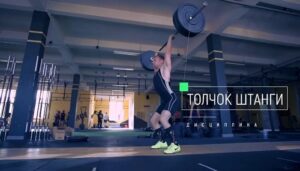In the article “Weightlifting” we will tell you about the sport, which is based on lifting weights. You will get acquainted with its history, with types and features of equipment.
#Weightlifting #Barbell #Weightlifters #Sports
Since time immemorial, athletes have shown their strength by lifting weights. Weightlifting was also popular in ancient Greece. It is said that in the central square of Athens there was a heavy stone ball. Anyone who wished could come up and try to lift it to demonstrate their abilities.
Weightlifting had a place of honor in the Ancient Olympics as well. Athletes took turns lifting stone blocks weighing 143 kilograms. Beginning in the second half of the 19th century, weightlifting began to develop as a sport in its own right. Athletic clubs appeared in many countries, clear rules for lifting weights were invented, and the weights themselves were improved.
In 1896 the 1st European Championship was held in Rotterdam, Holland. In the same year weightlifting made its Olympic debut. However, at that time it was a kind of general discipline of athletics.

Heroes of Russian bylinae from ancient times were famous for their heroic strength. So it is not surprising that in our country weightlifting is one of the favorite sports. Soviet athletes for many decades were considered the best in the world.
Our compatriots repeatedly became world champions and Olympic champions. Some Soviet weightlifters became true living legends. For example, Leonid Zhabotinsky and Yuri Vlasov. These athletes won many medals and titles during their careers. Their bout at the Tokyo Olympics (1964) is forever inscribed in the history of sports.
The rules in weightlifting may seem simple from the outside. You walk up to the platform, pick up the barbell and lift it over your head. But in fact, it’s not that simple, so let’s take a closer look at modern weightlifting.
These days, competitions are held in two disciplines: the snatch and the jerk. During the snatch, the athlete lifts the barbell above his head in one motion on straight arms.

Here’s how it works: In the starting position, the lifter’s legs are bent and the lifter squats low, leaning over the bar. He then raises the bar and straightens his back and quickly dives under the bar while it is inertially moving up. Now his task, holding the bar above his head, is to straighten his legs, and if he didn’t make a mistake, the jerk is done.
The jerk is performed in two steps and takes place as follows: In the first phase the athlete pulls the bar from the platform and lifts it to the chest. After that the second phase of the exercise begins, during which you must perform the following actions: a little squat and sharp movement to raise the bar, straightening arms.

Once the barbell is fixed at the top, the athlete must hold it with straight arms and stand at full height. It is important to maintain balance, not to make unnecessary movements with arms and legs, the athlete must be stable.
Each lifter has three attempts in each discipline. The best results in the jerk and snatch are summed up in the final figure. The one who took the highest total weight wins. World records are recorded separately: in the snatch, in the jerk, and total weight.
Weightlifting is unimaginable without the barbell. The first barbells were not similar to the modern ones, they were not even barbells at all. Over time, the shape of these sporting apparatuses became more and more similar to the modern form.

And finally, in the 60s of the last century, the very barbell that we used to see at competitions appeared. The length of the neck of the rod, as its metal rod is called, is 2.2 meters. The bar neck is made of a single piece of metal, because the hollow tube can break from the weight of the discs.
The all-metal neck weighs not a little, as much as 20 kg, so beginners start training by lifting an empty neck. The neck of the standard bar is 25 mm in diameter, the Olympic one is 3 mm thicker.
One of the latest technological innovations is the notches on the bar neck. An inconspicuous detail from prying eyes helps athletes to significantly increase the quality of approaches. The notches make the barbell more comfortable for athletes, it holds in their hands more firmly, and the standard factory marking helps to better navigate the geometry of the body.

The notches are located on both sides of the neck at a distance of no more than 81 cm from each other. For a weightlifter, they are like a repulsion bar for a jumper, they help to mark the most convenient grip so that the index finger of the hands is shoulder width apart. According to the rules of the competition, the neck can be marked only in case of its breakdown, but there have been no such precedents at major international tournaments so far.
The women’s Olympic barbell is similar to the men’s, but its neck is shorter by 15 centimeters and 5 kg lighter. The discs with which the barbell is weighted are called “pancakes” in sports slang. It is often possible to see disks of different colors, so the weight is indicated (marked). Multicolored pancakes are dressed on the neck in descending order, first heavier, then those that are lighter. An experienced athlete can determine the weight of the assembled barbell by color.

Calibrating the disk is a delicate job, because the shape of the disk must be perfectly flat, and the weight must be evenly distributed over the entire area (450 mm in diameter). The craftsman must not just cut off the excess weight if necessary, but do it all over the plane. Incredible precision must be maintained in order to keep the balance.
Rims were once metal, but modern technology has made it possible to find a more efficient material, synthetic rubber. Not only are the rims made of it more durable, they also have excellent shock absorbing qualities.
During competitions a weightlifter usually wears: weightlifting shoes, a special belt, knee bandages, tights and wristbands. Pants are a unique sports shoe for training and performance, which includes a heel.

The weight lifted above the head presses almost perpendicularly on the heel, and it is incredibly difficult to maintain it in flat shoes. The heel, on the other hand, by raising the heel by a couple of centimeters, transfers the emphasis to the entire sole, the support area increases, and the pressure on the foot is equalized. The sole of the shoe should not only withstand heavy loads, but also keep the foot from slipping. For this purpose, a rubber sticker is attached to the skin base.
The weightlifting belt protects the abs from stretching and helps support the back muscles. Safety technique in weightlifting is very important, because the athlete holds over his head a lot of weight, twice, or even three times more than his own weight.
Interestingly, the weight of the bar directly depends on the location of the competition. The same 200 kg barbell at the equator will weigh 1 kg less than at the pole. The main reason for this phenomenon is the centrifugal force, namely the rotation of the Earth around its axis.
The centrifugal force acts less on the body that is farther from the axis. At the equator, the centrifugal force is as if it were trying to lift the rod, compensating for the force of gravity. At the pole, the distance from the Earth’s axis of rotation is greater, and the influence of centrifugal force is minimal.

Each person’s muscles are made up of two types of fibers, slow and fast (the longer ones in the photo). The first ones provide endurance, the second ones provide explosive power. If this ratio is shifted in the direction of fast fibers, it means that you have all the prerequisites for weightlifting. The ratio of fast and slow fibers can be measured, for this purpose, scientists have designed a special testing complex.
Weightlifting can begin with 12-13 years. If you are older, you will probably not be enrolled in the section, but there are examples of people who started training at the age of 19 or 20 and eventually became great athletes. The key to success does not lie in age, but in physical qualities and perseverance.
In weightlifting strength is not only the classical formula, where mass multiplied by acceleration, it is also willpower. Mathematically this formula has not yet been deduced, but maybe only for now.
Weightlifting is the queen of sports!
FAQs
What is weightlifting?
Weightlifting is a strength sport in which athletes compete in 10 weight categories to lift weights over their heads. Competitions are held in two disciplines: snatch and jerk. It has been on the Olympic program since 1896.
How does weightlifting affect growth?
Weightlifting has no negative effect on a person's growth, as long as the exercises are supervised by an experienced coach and the load is not excessive. Weightlifting does not stunt bone growth, but strengthens it (increases density). If there are concerns about stunted growth, you can include pull-ups on the bar with your own weight or weights in your program.
How does weightlifting affect the heart?
Excessive and ill-conceived training in weightlifting lead to myocardial hypertrophy. In order to avoid the effects of weight training on the heart it is necessary: Before training, conduct a warm-up; Start training with the minimum weights; During the exercise, you must breathe properly; Monitor your heart rate, so it does not exceed 180 beats per minute (electronic heart rate monitor); Do not perform only basic exercises; Include cardio training (running, swimming) in the program.









